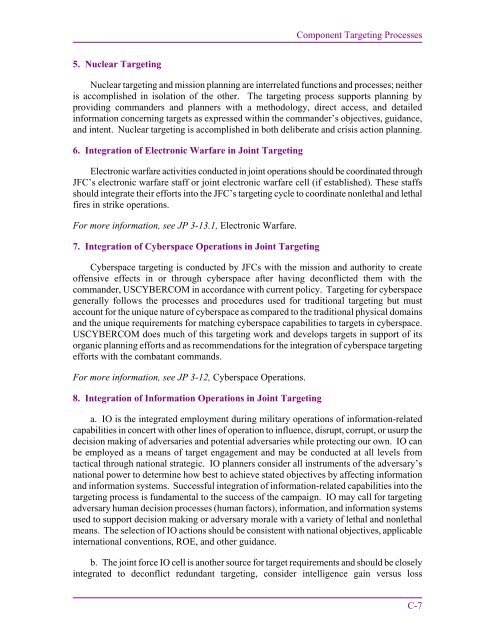Joint Targeting
1F87id9
1F87id9
You also want an ePaper? Increase the reach of your titles
YUMPU automatically turns print PDFs into web optimized ePapers that Google loves.
Component <strong>Targeting</strong> Processes<br />
5. Nuclear <strong>Targeting</strong><br />
Nuclear targeting and mission planning are interrelated functions and processes; neither<br />
is accomplished in isolation of the other. The targeting process supports planning by<br />
providing commanders and planners with a methodology, direct access, and detailed<br />
information concerning targets as expressed within the commander’s objectives, guidance,<br />
and intent. Nuclear targeting is accomplished in both deliberate and crisis action planning.<br />
6. Integration of Electronic Warfare in <strong>Joint</strong> <strong>Targeting</strong><br />
Electronic warfare activities conducted in joint operations should be coordinated through<br />
JFC’s electronic warfare staff or joint electronic warfare cell (if established). These staffs<br />
should integrate their efforts into the JFC’s targeting cycle to coordinate nonlethal and lethal<br />
fires in strike operations.<br />
For more information, see JP 3-13.1, Electronic Warfare.<br />
7. Integration of Cyberspace Operations in <strong>Joint</strong> <strong>Targeting</strong><br />
Cyberspace targeting is conducted by JFCs with the mission and authority to create<br />
offensive effects in or through cyberspace after having deconflicted them with the<br />
commander, USCYBERCOM in accordance with current policy. <strong>Targeting</strong> for cyberspace<br />
generally follows the processes and procedures used for traditional targeting but must<br />
account for the unique nature of cyberspace as compared to the traditional physical domains<br />
and the unique requirements for matching cyberspace capabilities to targets in cyberspace.<br />
USCYBERCOM does much of this targeting work and develops targets in support of its<br />
organic planning efforts and as recommendations for the integration of cyberspace targeting<br />
efforts with the combatant commands.<br />
For more information, see JP 3-12, Cyberspace Operations.<br />
8. Integration of Information Operations in <strong>Joint</strong> <strong>Targeting</strong><br />
a. IO is the integrated employment during military operations of information-related<br />
capabilities in concert with other lines of operation to influence, disrupt, corrupt, or usurp the<br />
decision making of adversaries and potential adversaries while protecting our own. IO can<br />
be employed as a means of target engagement and may be conducted at all levels from<br />
tactical through national strategic. IO planners consider all instruments of the adversary’s<br />
national power to determine how best to achieve stated objectives by affecting information<br />
and information systems. Successful integration of information-related capabilities into the<br />
targeting process is fundamental to the success of the campaign. IO may call for targeting<br />
adversary human decision processes (human factors), information, and information systems<br />
used to support decision making or adversary morale with a variety of lethal and nonlethal<br />
means. The selection of IO actions should be consistent with national objectives, applicable<br />
international conventions, ROE, and other guidance.<br />
b. The joint force IO cell is another source for target requirements and should be closely<br />
integrated to deconflict redundant targeting, consider intelligence gain versus loss<br />
C-7


